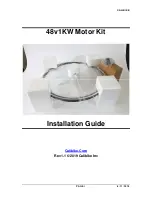
9
|
2.
Unloose the nuts on the axis of both small wheels. If necessary, tighten the play of bearings so
that the wheels can turn freely (that is so that they do not drag and at the same time they are
not free) – (depending on the model).
3.
Insert the fork tube through the handlebars tube, insert the handlebars in it and tighten
properly with a bushing.
4.
Insert the seat into the seat tube to a required height and tighten the bushing.
5.
If the brake is included, insert the oval ending of brake cable into a major hole (for diff erent
types of levers, the grippings may diff er) situated on the brake lever and insert the brake
cable into the slot on the inferior part of the handlebars (see picture
). Press both arms
of the V-brake towards the wheel rim and with an appropriate key (according to the model)
adjust the brake lining so that during the braking, the brake lining chafes with its whole brake
surface against the side part of the rim (picture
). If necessary, tighten or loosen the brake
cable with the anchoring bolt (picture
) or with the adjusting screw on the brake lever
so that there is, between the rim and the brake lining, a distance of approximately 1 – 2 mm
(picture
). If the wheel does not turn freely and „slackens up“ on one side, it is possible
to adjust this by tightening the tension bolt at the arm of the V-brake that „slackens up“ the
wheel (picture
), eventually by loosening the tension screw at the arm of the V-brake
which is more distant from the rim so that the wheel may turn freely.
Control the good functioning of the brake before riding.
In case the device for taking off has also the front brake – mount it and adjust it in the same
way.In case the brake lever (on the handlebars) contains the adjusting screw (situated on the
side of the lever), by its tightening it is possible to achieve a shorter distance between the
lever and the grip (according to the size of the hand).
6.
Pump up the tyres according to the rider, maximally to the value marked on the
tyre (bar/psi).
OPERATING INSTRUCTIONS FOR RIDING
By sitting on the seat, holding the handlebars with both hands and taking off alternatively
once with a right and afterwards with a left foot (like when running), you will achieve the
ride. By lifting the feet during the ride, the children learn how to keep balance in a controlled
manner. The braking takes place by braking with feet, the same like when you are running, or
by pressing the brake lever (if it is included).
MAINTENANCE
We recommend to entrust a professional service with it.
Control regularly, eventually
tighten or adjust: screw connections, tightening mechanisms, lubricate sliding parts (wheels
bearings, handlebars bearings, cables, brake parts etc.), when dirty, clean with a humid cloth.
Before each ride, control all the screws and their tightening, eventually a correct functioning
of the brake (if included). In case some parts are worn (tyres, bearings, brake parts etc.),
for the security of the rider it is necessary to substitute them (by parts according to original
parameters) and adjust. When dirty, clean with a humid cloth, do not use ammonium, oil
products, solvents and other chemicals. For the wheel bearings, use sewing machines oil and
bicycles oil. After the fi rst run-in period, we recommend to tighten the wires (according to the
model) equally by 2 turns (entrust a professional service with it).
ATTENTION:
During the lubrication, the lubricant must not get onto the braking
friction surface of the rim and the brake lining. If this situation occurs, it is necessary to
remove the grease from all brake parts, eventually clean with a technical gasoline. If during
Summary of Contents for Fifty 50
Page 27: ... 26 ...











































